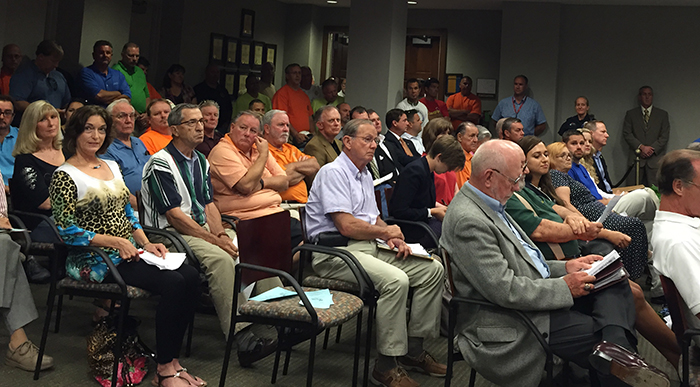As the torrents of disheartening news continue to rain down on us, many people are starting to wonder how all of Trump’s draconian policies are going to affect them. One of Trump’s most disheartening cabinet appointments is Carl’s Jr. CEO Andrew Puzder. The executive has a history of being anti-minimum wage (and protests for a higher living wage) and literally wrote a book about deregulation.
Under Obama, working people had many challenges. Bernie Sanders famously ran a campaign on a rigged economy where management is set up to beat workers every time. The playing field is about to get even more uneven. How are you going to protect yourself? One of the best ways to do that is to join a union in solidarity with your fellow workers. Here’s how you can get started.
Is My Industry Unionized?
It may be possible that your line of work is organized, but you just don’t know it yet. The AFL-CIO alone has over 50 unions under its banner as diverse as Bakery, Confectionery, Tobacco Workers, and Grain Millers International Union (BCTGM) and International Plate Printers, Die Stampers, and Engravers Union of North America. Due to the systematic weakening of the labor movement by Republicans and the changing nature of our jobs, you may be in line of work that could be unionized and you just don’t know about it. One great example of how unions have adapted to changing workplaces is in the Writers Guild of America. Though the WGA has long been known for primarily representing screenwriters and traditional journalists, the WGA East has led a campaign to organize digital outlets, including Salon, Gawker, and Vice. Many writers who ended up unionizing had no idea that their work could be eligible for collective bargaining.
What If My Industry Isn’t Unionized?
The Fight for 15 has catapulted into the national consciousness during its five-year struggle. Though the focus has been fighting for 15-dollar minimum wage nationwide, the movement has also been instrumental in getting fast food and retail workers to think about organizing. In fact, the movement was launched by a labor union, the SEIU (Service Employees International Union) in 2011, and the official aim of the movement is “15 dollars and a union.” As the movement continues, many workers, like Burgerville employees in the Pacific Northwest, are working hard to organize.
Conservatives have gone to great pains to differentiate labor that is “worthy” of having a union from jobs that they don’t think deserve basic human decency. You’ve probably seen a variation of this meme.
The tactic here is to convince workers in the fast food and retail spaces that they aren’t worth $15 an hour rather than asking why soldiers, EMTs, and other “worthy” professions don’t make more money. Management engages in these tactics with their employees as well. When I worked at the Apple Store, they paid $14 an hour, but also made us sit through seminars about why labor organizing is actually bad for the individual worker. Target and Walmart employees report the same thing. Organizing is an essential part of understanding your rights as a worker and realizing the potential of what you’re worth under collective bargaining. If management wants to pay workers as little as possible, under capitalism it is a worker’s duty to advocate for as much as possible.
That’s where labor unions come in, and many of the larger unions, like the AFL-CIO, the Teamsters, and the SEIU, are looking to organize spaces that have never been unionized. The Teamsters and the SEIU have made gains on behalf of fast food workers, paving the way for them to organize, including the right to bargain with ownership and not just franchises (most fast food restaurants operate on a franchise model). The SEIU has also made significant progress organizing airport workers who hadn’t previously been unionized.
What Can I Do Today?
Ideally, you would be able to get the assistance of a larger union with experience and personnel to assist you in organizing. However, there are steps you can take without a larger organization’s assistance that can move you towards being a union member. Hawai’i’s AFL-CIO offers a nice primer on how to move towards organization. If you choose to, you can organize through the NLRB (National Labor Relations Board) directly. In this case, you would want to make sure that at least 50 percent of your co-workers want to organize and then file paperwork through them. You will then send a named “bargaining unit” to deal with the NLRB on behalf of your workplace. Once you’ve done this, there are still a number of other steps, including winning union elections and signing a contract. The AFL-CIO recommends organizing carefully with a small committee of co-workers before you do this to ensure success (which, again, is why many workers choose to organize with a larger union). If you fail to get the votes needed in front of the NLRB, you have to wait another year before you can try to organize again. Even if you don’t choose to be under the umbrella of a larger union, it is a good idea to consult a local union—you’ve definitely got some teachers or truckers in your area—for advice as your proceed.
Unionizing will be a long, hard effort. Management doesn’t want unions, and they are known to pursue any manner of tactics to stop organizing. Sometimes this is a microscopic as pitting workers against each other in the break room. Sometimes it is as big-picture as passing a new round of state right-to-work laws. This is why we need solidarity. The only way to beat big business and stand up for the little guy is to stand together. That’s what solidarity and unions are all about. Best of luck out there. Solidarity forever.











